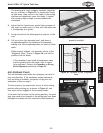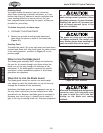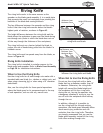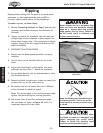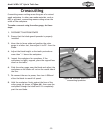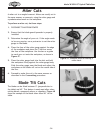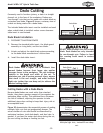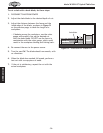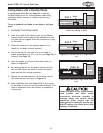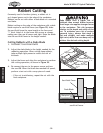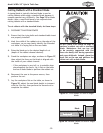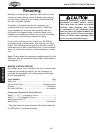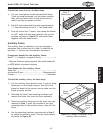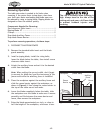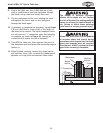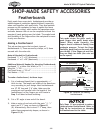
Df[\cN(/)+('?pYi`[KXYc\JXn
-37-
FG<I8K@FEJ
Blade
Workpiece
Fence
Cut 1
Figure 52. First cut when using a single
blade for making a dado.
Cutting Dados with a Standard Blade
A ripping blade (described on Page 25) is typically
the best blade to use for cutting dadoes when using
a standard blade, because it removes sawdust very
efficiently.
To use a standard saw blade to cut dadoes, do these
steps:
1. DISCONNECT SAW FROM POWER!
2. Mark the width of the dado cut on the workpiece.
Include marks on the edge of the workpiece so the
cut path can be aligned when the workpiece is lying
on the table.
3. Raise the blade up to the desired depth of cut
(depth of the dado channel desired).
4. Set up the saw for the type of cut you need to
make, depending on if it is a rip cut (see Page 32) or
crosscut (see Page 33).
5. Align the blade to cut one of the dado sides, as
shown in Figure 52.
6. Re-connect the saw to the power source and turn
the saw ON. Allow the blade to reach full speed,
then perform the cutting operation.
7. Repeat the cutting operation on the other side of
the dado channel, as shown in Figure 53.
8. Make additional cuts (see Figure 54) in the center
of the dado to clear out the necessary material. The
dado is complete when the channel is completely
cleared out.
Workpiece
Fence
Cut 2
Blade
Figure 53. Second cut for a single dado
cut.
Nfibg`\Z\
=\eZ\
Cuts 3+
Figure 54. Additional single blade dado
cuts.
Always use push sticks, featherboards,
push paddles and other safety
accessories whenever possible to
increase safety and control during
operations which require that the
blade guard be removed from the saw.
ALWAYS replace the blade guard after
dadoing is complete.



